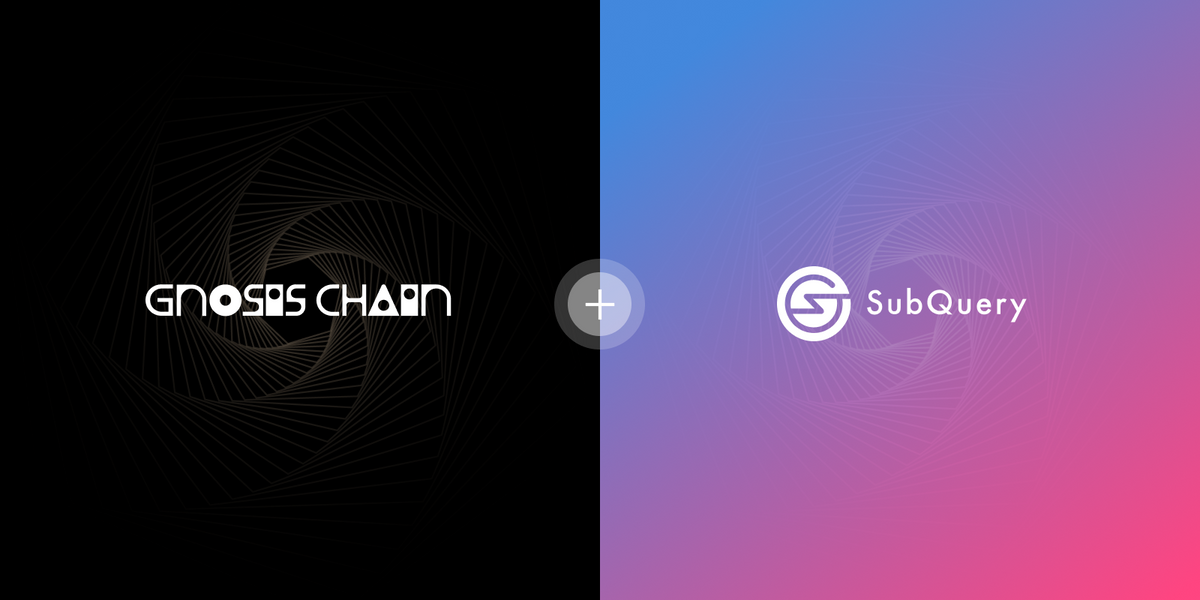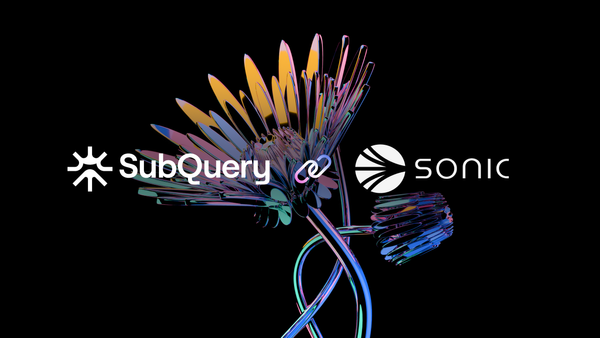This week brings forward another big milestone for SubQuery’s indexing support, with the launch of support for Gnosis Chain. Gnosis Chain is an EVM compatible, community owned network that prioritises credible neutrality and resiliency, open to everyone without privilege or prejudice. Gnosis Chain is secured by over 100k validators around the world.
We’re pleased to work with GnosisDAO to bring SubQuery’s flexible, fast, open, and decentralised data indexing solution that provides blockchain developers with the tools needed to easily organise and query on-chain data for their protocol and applications. Abstracting the backend, SubQuery provides a custom API and lets developers focus on product development and user experience rather than building their own indexing solutions.
We’re always striving to provide developers with the most comprehensive and efficient indexing solutions possible. SubQuery has already proven to be faster than The Graph on Ethereum and other EVM chains, offering Gnosis Chain developers another decentralised alternative with the impending launch of the SubQuery Network. That’s why we’re thrilled to announce our latest integration with one of the most exciting EVM chains in the Web3 space.
“Gnosis Chain has always strived for a diverse and decentralised network, this mission also extends to the infrastructure and tooling providers that support decentralised applications on our network. We’re pleased to welcome SubQuery as another data indexer for Gnosis, and a critical tool to help dApp developers create and grow their dApps in Gnosis” - Arsenii Pechenkin, DevRel at Gnosis Builders
Gnosis Chain developers will benefit from the superior SubQuery indexing experience, including the open-source SDK, tools, documentation, and developer support that the SubQuery ecosystem provides. Gnosis Chain is also supported in SubQuery’s enterprise level managed service, which provides enterprise level infrastructure hosting and handles hundreds of millions of requests each day.
"We are thrilled to announce our integration with Gnosis Chain, a leading blockchain platform known for its advanced decentralized exchange and prediction market capabilities. This collaboration empowers Gnosis developers with unparalleled access to valuable on-chain data, revolutionizing the way they interact with the blockchain. Exciting times ahead for decentralized applications and innovation!" - Sam Zou, Founder and CEO of SubQuery
Our experience with customers across all verticals in Ethereum, Polygon, Polkadot, Cosmos, Algorand, NEAR and Avalanche (such as wallets, networks, explorers, NFT, DeFi, scanners, etc.) has helped us build the best Indexer for developers in web3.
SubQuery is currently focused on decentralising and tokenizing the protocol to build the SubQuery Network. The SubQuery Network will index and service data from projects to the global community in an incentivized and verifiable way and support indexing Gnosis Chain projects, and those from any other supported Layer-1 from the outset.
The Gnosis integration is live and ready to be used in production by projects across the network. We’re working closely with a few select customers to test and optimise this integration — if you would like to join SubQuery as an Gnosis Chain launch partner or receive help migrating from The Graph, please reach out to sales@subquery.network.
Why Use SubQuery?
SubQuery also brings some major improvements to existing decentralised indexing solutions, including users of The Graph. For one, SubQuery is far more flexible with the ability to make external API calls or import external libraries from within your mapping functions, and better controls to run your projects in your own infrastructure with automated DOS (denial of service) mitigation controls. Additionally, we have no plans to sunset our managed service.
Both SubQuery and The Graph are designed to index data fast, but analysis shows that the existing beta support from SubQuery is already 1.85x faster for common projects over The Graph (e.g the standard Ethereum Name Service project). This adds up when you’re indexing millions of blocks, and is something to consider when choosing your indexer. SubQuery achieves this by using mulit-threading and optimisation of the store to reduce costly database writes. With faster sync times, developers can iterate faster and deliver features to market quicker.
And finally, in a few months you’ll be able to completely decentralise your SubQuery infrastructure with the SubQuery Network, the future of Web3 infrastructure. The SubQuery Network will index and service your projects data to the global community in an incentivised and verifiable way. It is designed to support any SubQuery project from any supported network including Gnosis Chain, so you can take advantage of the scale of the unified SubQuery Network from launch.
Read more about the advantages of SubQuery over other options here.
Getting Started with SubQuery and Gnosis
The best way is to start by following our step by step guide using a real world example project. Follow our quick start tutorial to see how to index all POAPs issued on Gnosis Chain in only 15 minutes.
With SubQuery’s Gnosis integration, there are three types of mapping handlers:
- BlockHandler: All blocks and their hash and height
- TransactionHandler: All transactions and their hash, height, and timestamp
- LogHandler: On each and every log that matches optional filter criteria, access various data from the Gnosis logs
We’ve updated the SubQuery Documentation to add Gnosis specific information to the general SubQuery documentation.
Migrating From The Graph
When we set out to build SubQuery, we always planned to massively improve on the developer experience of other providers, like The Graph, while ensuring that migrating your project to SubQuery is as easy as possible.
Gnosis developers can benefit from the superior SubQuery experience, including the open-source SDK, tools, documentation, and developer support that the SubQuery ecosystem provides. Additionally, SubQuery’s Gnosis implementation has been designed to operate almost identically to existing EVM support from other networks that SubQuery already supports, including Ethereum, Polygon, BNB Smart Chain, Arbitrum, Optimism, Avalanche, Flare, Cosmos (Ethermint), and Polkadot (FrontierEVM).
If you are an existing user of The Graph, you can follow the guide here to migrate your project to SubQuery and supercharge your indexing today. The migration from a SubGraph to a SubQuery Project is (by design) easy and quick. It may take you an hour or two to complete the migration, depending on the complexity of your SubGraph.
If you would like to find out more about how SubQuery compares to other popular indexers, read our Indexer Comparison article.
SubQuery’s Support for Gnosis Chain
- Advanced Indexing of blocks, transactions, and logs
- A quick start guide on how to index all POAPs on Gnosis chain
- Full support for Gnosis in our free enterprise level managed service
- Two example SubQuery Projects
- Index all Gnosis POAPs (with quick start guide)
- Transfers of ChainLink Token on xDai on Gnosis
- Discord community (including technical support)
About Gnosis Chain
Gnosis Chain is an EVM compatible, community owned network that prioritizes credible neutrality and resiliency, open to everyone without privilege or prejudice. Secured by over 100k validators around the world, Gnosis Chain has all the tooling you are used to and trustless bridges to mainnet soon. Using the same execution and consensus layer clients as Ethereum, Gnosis Chain is compatible with all future EIPs.
Its diverse validator set and the community governance ensure Gnosis Chain remains credibly neutral at a much lower price point than mainnet. Only 1 GNO is required to spin up a validator and the process is user-friendly.
Gnosis Chain uses a dual-token model. xDAI is a stable token used to pay for the execution of smart contracts and gas fees, and GNO is used for staking as the governance token for the GnosisDAO.
Website | Discord | Twitter | Blog | Discord | Substack | Github Repo | YouTube | Reddit
About SubQuery
SubQuery is a blockchain developer toolkit facilitating the construction of Web3 applications of the future. A SubQuery project is a complete API to organise and query data from Layer-1 chains. Currently servicing Ethereum, Polygon, BNB, NEAR, Polkadot, Avalanche, Algorand, Arbitrum, Gnosis Chain, Cosmos and Flare projects, this data-as-a-service allows developers to focus on their core use case and front-end without wasting time building a custom backend for data processing activities. In the future, the SubQuery Network intends to replicate this scalable and reliable solution in a completely decentralised manner.
Linktree | Website | Discord | Telegram | Twitter | Matrix | LinkedIn | YouTube







